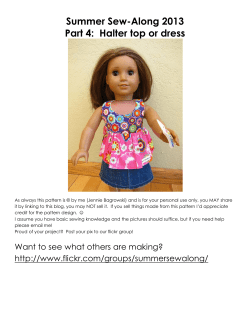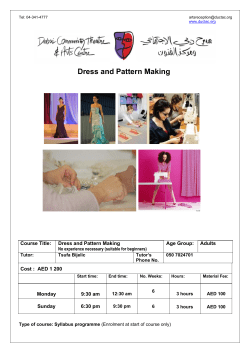
FASHION DESIGN FAD 140
FASHION DESIGN
CODE: FAD 140
TITLE: Technical Skill for Apparel I
DIVISION: Science Math and Technology
COURSE DESCRIPTION: This course introduces flat pattern methods for designing basic
apparel. Students demonstrate an understanding of the aesthetic and technical
characteristics of a well-designed garment, including awareness of the role a target
market plays in creation of the design.
PREREQUISITE: FAD 130
CREDITS:
4
cr.
REQUIRED MATERIALS (CHECK BOOKSTORE FOR LATEST EDITION):
Click on the bookstore for the campus which you are attending each class.
Pemberton Campus Bookstore
Mount Laurel Campus Bookstore
COURSE LEARNING OUTCOMES:
1. Define pattern drafting, and demonstrate techniques required for the execution
of an accurate, well-marked soft paper ("first") pattern. Verbally list the
features, marking, and identification required on all finished patterns; be able
to complete a pattern and submit class work according to course criteria as
established by the instructor and/or CD-Rom
2. Draft the basic bodice front and the basic bodice back for a complete basic
bodice pattern. May refer to textbook.
3. Describe the purpose of the industrial dress form; identify major dress form
body locations and how they are designated, demonstrate ability to measure
and record dress form dimensions accurately, and describe how the dress form
and dress form locations are critical to the pattern drafting process.
4. Be able to define and use industry appropriate terminology pertaining to the
design room first pattern drafting process, to include vocabulary related to
workroom procedures, methods, concepts, and tools.
5. Demonstrate knowledge of the dart rotation principle, using half-scale patterns
of the (one-dart front) bodice. Demonstrate through the slash and spread
method the principle of dart equivalents; list three dart equivalents.
6. Demonstrate understanding of the principle of dart rotation and effect on
bodice grain through the execution of fashion fabric samples, and through the
execution of a pattern for a princess-styled bodice done with the aid of a twodart bodice sloper.
7. Identify the parts of the collar. Draft one shirt or convertible collar and two
collar variations. Define: Peter Pan, Mandarin/standing, and convertible
collar. Using the text, be able to independently draft these collar variations
successfully.
8. Produce a completed pattern for a skirt with a waistband that demonstrates
one principle of patternmaking, with zipper and button closure, using the
student's basic skirt sloper and the textbook or as directed by the instructor.
Student must also have the ability to independently draft a pattern for a
variation of the basic skirt.
9. Produce a completed pattern for one of the following: a gored skirt, a pegged
skirt, a skirt with added flare and yoke, a circle skirt, or a gathered, dirndl
skirt; all with waistbands or faced waist openings. May refer to textbook for
variation but must work independently.
10. Use folded paper to demonstrate a kick pleat, knife pleat, or inverted box
pleat. Describe how this pleat is incorporated into many straight skirt styles,
and why. Draft a straight sleeve using the textbook. Transfer to muslin, fit into
muslin bodice drape, correct, mark, and transfer to hard paper to complete the
student's sloper set.
11. Produce a complete pattern for a peasant blouse, or blouse style as directed by
the instruction.
12. Choose one sleeve variation and execute a draft: lantern, bell, leg-o-mutton, or
bell sleeve.
13. Complete a complete shirt pattern, to include yoke, basic shirt sleeve, front
with buttonhole guide, sleeve vent variation, cuffs, and shirt collar.
GENERAL EDUCATION OUTCOMES IN THIS COURSE:
Written and Oral
* Students will communicate meaningfully with a
Communication: Communication chosen audience while demonstrating critical thought.
Technological Competency or
Information Literacy:
Technology
* Students will demonstrate competency in office
productivity tools appropriate to continuing their
education.
TOPICAL OUTLINE FOR THE COURSE:
Introduction to class content, review syllabus and supply list, explain grading methods
and projects due.
Overview of pattern making conventions, marking, vocabulary, and drafting techniques.
How to copy front and back bodice (size 8) slopers.
Demonstration: change the basic two-dart sloper to a one-dart sloper and transfer the
draft onto oak tag. (No seam allowance and 1/2 front and back).
"Dart Manipulation"
Single-dart series, using both slash and spread technique and pivot technique.
Draft one variation from the single-dart series including Basic Front with 1 dart and Basic
Back with 2 darts.
Draft 2 Variations from the single-dart series. (3 total incl. the previous one draft done.)
Presentation: Two bodices, which will include - draft, finished pattern (full Front and full
Back incl. seam allowances) and Front and Back bodices sewn in striped fabric.
Demonstrate: Using a two-dart front bodice, transfer of the underarm dart to new
positions (armhole, shoulder).
Demonstrate: Development of a princess seam bodice from one of the above mentioned
two-dart drafts.
Draft completed pattern (full Front and full Back)
Draft a two-dart variation and princess variation
Copying basic front and back skirt.
Demonstration: A-Line, flared skirt, and a skirt with added fullness.
Draft two skirt variations with completed patterns.
Mid-term project - 1 completed skirt pattern and skirt sewn in fashion fabric, including 2page Specification Sheet: Sketch Sheet and Measurement Worksheet.
Demonstration: skirt with faced waist, skirt variations (gored, pegged), circle skirt.
Draft 1 gored skirt with faced waist with completed pattern
Demonstration: skirt with yoke.
Draft 3/4 and 1/4 circle skirts
Demonstration: folded pleat variations, (Kick, Knife, Inverted, Accordion Pleats).
Draft in paper 1 of each pleat variation.
Introduction to shirt pattern (Final Project)
Demonstration: shirt with yoke and shirt sleeve.
Draft shirt drafts with open book.
Discuss/demonstrate hemline options (cuffs, sleeve vent etc.), Demonstration: self faced
front band (stitched, folded, stitched with button hole spacing), basic shirt collar and
collar band (Mandarin).
Demonstration: sleeve variations - Puff, Lantern, Leg o'Mutton, collar variations - Peter
Pan and Sailor collar.
Draft Peter Pan and Sailor collar.
Demonstration: Peasant Blouse.
Draft Peasant blouse draft.
Final project---a completed shirt pattern that meets criteria set by instructor.
COURSE ACTIVITIES:
Course activities vary from course to course and instructor to instructor. Below is
a listing of some of the activities students can anticipate in this course:
Writing assignments: students will analyze current issues in the field using
current articles from the popular press as well as library research including
electronic resources databases.
Speaking assignments: students will present research individually or in groups
using current technology to support the presentation (e.g., PowerPoint
presentation); students will participate in discussions and debates related to the
topics in the lessons. Discussions may also focus on cross-cultural and legalethical dilemmas as they relate to the course content.
Simulation activities: Trends and issues will analyzed for their ethical as well as
social or legal significance. Students might role-play common situations for
classmates to analyze. Current news articles may be used to generate discussion.
Case Studies: Complex situations and scenarios will be analyzed in cooperative
group settings or as homework assignments.
Lectures: This format will include question and answer sessions to provide
interactivity between students and instructor.
Speakers: Representatives from various related fields may be invited to speak.
Videos: Related topics will provide impetus for discussion.
EDUCATIONAL TECHNOLOGY:
Burlington County College advocates a technology enhanced teaching and learning
environment. Advanced technological tools may be used in any course section to
facilitate instruction. Many of our sections are web-enhanced, which means that some of
your work will be submitted or completed online. Web enhancements may include online materials, grade books, testing and quizzes and assignment submission. Many
students enjoy the flexibility and convenience that these online enhancements have
provided, however if you have concerns about the technology involved, please speak to
your instructor immediately.
STUDENT EVALUATIONS:
The student will be evaluated on the degree to which student learning outcomes are
achieved. A variety of methods may be used such as tests, quizzes, class participation,
projects, homework assignments, presentations, etc.
See individual instructor’s course handouts for grading system and criteria (point value
for each assessment component in course, e.g. tests, papers, presentations, attendance
etc.), number of papers and examinations required in the course, and testing policy
including make ups and/or retests.
GRADING STANDARD:
A
B+
B
C+
C
D
F
Mastery of essential elements and related concepts, plus demonstrated excellence
or originality.
Mastery of essential elements and related concepts, showing higher level
understanding.
Mastery of essential elements and related concepts.
Above average knowledge of essential elements and related concepts.
Acceptable knowledge of essential elements and related concepts.
Minimal knowledge of related concepts.
Unsatisfactory progress. This grade may also be assigned in cases of academic
misconduct, such as cheating or plagiarism, and/or excessive absences.
For other grades, see the current BCC catalog.
COLLEGE POLICIES:
The current college catalog and student handbook are important documents for
understanding your rights and responsibilities as a student in the BCC classroom. Please
read your catalog and handbook as they supplement this syllabus, particularly for
information regarding:
Academic Integrity Code
Student Conduct Code
Student Grade Appeal Process
NOTIFICATION:
Burlington County College offers reasonable accommodations and/or services to persons
with disabilities. The Special Populations Department offers comprehensive services to
all students with any form of disability which hinders their academic success as long as
the student provides appropriate documentation. Contact Special Populations at
Extension 1208 at (609) 894-9311 or visit the website at:
http://www.bcc.edu/pages/209.asp
ADDITIONAL SUPPORT/LABS:
BCC provides academic advising, student support personal counseling, transfer advising,
and special accommodations for individuals with disabilities free to all students through
the Division of Student Services. For more information about any of these services, visit
the Parker Center on the Pemberton Campus or Laurel Hall on the Mt. Laurel Campus, or
call (609) 894-9311 or (856) 222-9311, then dial the desired extension:
- Ext. 1557 Academic Advisement and Counseling
- Ext. 1803 Special Populations
- Ext. 2737 Transfer Center
Or visit the following websites:
Academic Advising
E-Advising
Student Support Counseling
Transfer Center
http://www.bcc.edu/pages/206.asp
http://www.bcc.edu/pages/219.asp
http://www.bcc.edu/pages/274.asp?subdisp=1&subpar=206
http://www.bcc.edu/pages/185.asp
BCC offers a free tutoring for all currently enrolled students. For more information
regarding The Tutoring Center call Extension 1495 at (609) 894-9311 or (856) 222-9311
or visit the Tutoring Center Website at http://staff.bcc.edu/tutoring/
Annual Review 2011-2012
DS
© Copyright 2025














